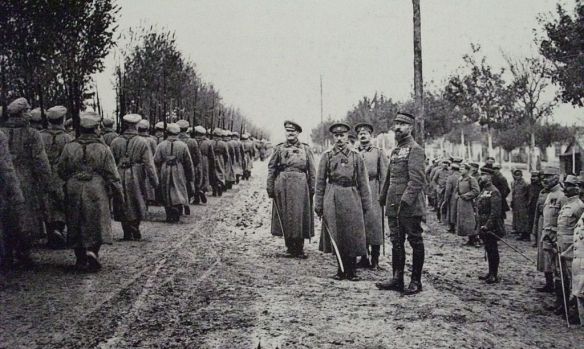Russian troops parading in front of général Henri Gouraud and général Nikolaï Lokhvitski at camp de Mailly in October 1916.
General N. Lokhvitskiy inspecting positions accompanied by Russian and French Officers in the summer of 1916 in Champagne.
Travel of the Russian Expeditionary Force to the Western Front
Surprisingly, at this time of preparation for the great offensive of 1916 – and even more surprisingly in view of the millions of casualties already suffered and men taken prisoner – Russia was sending troops abroad. When Vasily Lodshina was being deafened by the guns in the forest, 1st Special Brigade of the Russian Expeditionary Force landed at Marseille to fight on the Western Front. Visiting Russia in December 1915 future French president Paul Doumer had asked for 300,000 men, which ridiculously high figure was based on the assumption that Russia had unlimited reserves of trained manpower. At Stavka, General Alekseyev was understandably against sending any men to France, in addition to those already destined for the Salonika front. The Tsar, however, overrode his objections in return for Doumer’s promise of armaments and eventually compromised on sending a brigade, providing it was to serve under Russian officers, be equipped by the French, and be transported by the French navy.
Comprising one regiment from each of Moscow and Samara, the brigade numbered 8,942 men, with factory workers predominating in 1st Regiment and peasants in 2nd Regiment. Contemporary photographs show French officers on the quayside at Marseille in April 1916, saluting the new arrivals after their ten-week journey from Moscow, via the Trans-Siberian railway and by sea from Dal’ny around China, across the Indian Ocean, through the Red Sea and Suez Canal. On board one of the four French ships, some Russian officers return the salutes, while most of their men see Europe for the first time with no apparent emotion. They parade through the Old Town in front of curious, but not very large, crowds before being transported by rail to Mailly le-Camp in Champagne, preparative to being sent into the line. Killing time for a few days there, they eat, smoke and watch two burly NCOs doing energetic Cossack knees-bend dancing to music played on an accordion. In a safe trench on the French-held sector of the Champagne sector of the line, their commander, General Nikolai Lokhvitsky, poses for a photographer. For him and the other officers, with fluent French as their second language, liaison was not a problem. For their conscripts in the brigade, it was a different story. At that point, the photographic record ends, but the documentary record continues, to end in tragedy.
A few days after setting foot on French soil, 1st Special Brigade was transported to Châlons-sur-Marne and attached to General Henri Gouraud’s 4th Army, ‘going up’ to the line around Auberive at the end of June. Like their brothers-in-arms on the Russian fronts, the men of 1st Special Brigade fought and suffered in the trenches, being joined later by 3rd Special Brigade, shipped from Archangel to Brest in September, while 2nd and 4th Russian Special Brigades were in Macedonia, fighting the Bulgarians. In all, some 45,000 officers and men were sent to fight in France. There is a military cemetery at Mourmelon-le-Grand containing the graves of 1,000 Russian officers and men. Somewhat belatedly, the French nation erected a memorial equestrian statue on the bank of the Seine in Paris in 2011.
News of the Tsar’s abdication in March 1917 and of the mutinies on the Russian fronts divided the men’s loyalties, with many of the more politically active townsmen in 1st Brigade refusing to fight and demanding to be repatriated while the peasants of 3rd Brigade remained under the discipline of their officers, prepared to continue the war. The generals might have been able to fool themselves that the loss of millions of lives was justified in some unprovable way, but the men in the front lines had long ceased believing in anything, except the likelihood that they would soon be corpses. Because the French army was suffering mutinies with many men being summarily shot in front of their comrades pour encourager les autres, the mutinous Russians were moved to where they were less likely to spread dissent at the front. At the huge military camp of La Courtine in Central France, attempts were made by Russian and French officers to restore order in 1st Brigade. After 3rd Brigade was ordered to surround the mutineers’ camp, there ensued five days of scuffles and argument before a Russian-manned battery of French field guns shelled the mutineers, causing fifty casualties.
The surviving mutineers were despatched to concentration camps, some as far away as the Sahara desert, then policed by the French Foreign Legion, where conditions were horrific. Most officers and some men, however, volunteered to form the Légion Russe, which continued the fight until the Armistice in November 1918. By then, few of these legionnaires thought it was safe to return to Russia under the Bolsheviks. Since France had been a pays d’accueil for refugees from European monarchies ever since the Revolution, they opted to stay there on demobilisation. This produced the strange phenomenon between the wars, when it seemed that the majority of taxi-drivers in Paris were former Russian officers, as were many of the commissionaires outside posh hotels.
